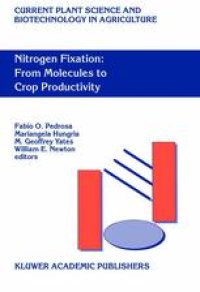
Ebook: Nitrogen Fixation: From Molecules to Crop Productivity
- Tags: Plant Sciences, Plant Physiology
- Series: Current Plant Science and Biotechnology in Agriculture 38
- Year: 2002
- Publisher: Springer Netherlands
- Edition: 1
- Language: English
- pdf
The 12th International Congress on Nitrogen Fixation was held in Foz do Iguaçu, Paraná State, Brazil, from the 12th to 17th of September, 1999. This volume constitutes the proceedings of this Congress and represents a compilation of the presentations by scientists from 38 countries who came to discuss the progress made, to exchange views and to collaborate. Since the first meeting in Pullman, Washington, USA, in 1974, this series of Congresses has been held three times in the United States, four times in Western Europe, in Australia, Mexico and Russia, and now for the first time in South America. Brazil was a most appropriate choice because Brazilian agriculture is especially dependent on biological nitrogenfixation. An important example is the soybean crop. The 30 million metric tons of grain produced each year relies solely on symbiotic nitrogen fixation. N-fertilizers are expensive in Brazil and, in the absence of the biological process, this crop would require 4-5 M tonnes of N at an annual cost of almost 1 billion dollars. Crop rotation, soil reclamation, forestry, forage mixed cropping, intercropping with grasses and legumes, associative nitrogen fixation with non-legume crops, such as sugarcane, and other agricultural practices in Brazil are also dependent on biological nitrogen fixation. The Brazilian experience with biological nitrogen fixation is a paradigm to be followed by all countries where nitrogen fertiliser is expensive or where present day environmental concerns demand a feasible, efficient and inexpensive alternative to chemical N-fertilizers.
This book brings together the diverse disciplines that study nitrogen fixation and describes the most recent advances made in various fields: chemists are now studying FeMoco, the active site of nitrogenase in non-protein surroundings, and the crystal structure of the enzyme has been refined to 1.6 angstroms. Recent advances in the complex regulation of nitrogen metabolism and nitrogen fixation gene expression in the free-living, associative, endophytic, symbiotic and photosynthetic diazotrophs are detailed, as well as factors involved in the nodulation process and nodule metabolism in legumes.
In recent years molecular techniques have expanded phylogenetic studies and genome sequencing. Extensive studies on biological nitrogen fixation in sustainable agriculture, particularly in the tropics, environmental stress on plants and microbes, rhizobial strain selection, methods of soil reclamation and newly discovered plant bacterial associations are described. Finally, the possible avenues of nitrogen fixation research in the coming century, including the expression of nitrogen fixation genes and the establishment of nitrogenase function in plant organelles, the prospects of developing nitrogen fixation in rice and the development of resistant transgenic legumes are explored. All these developments were discussed at the 21st International Congress on Nitrogen Fixation held at Foz do Iguassu, Paraná State, Brazil, and are covered in these proceedings.